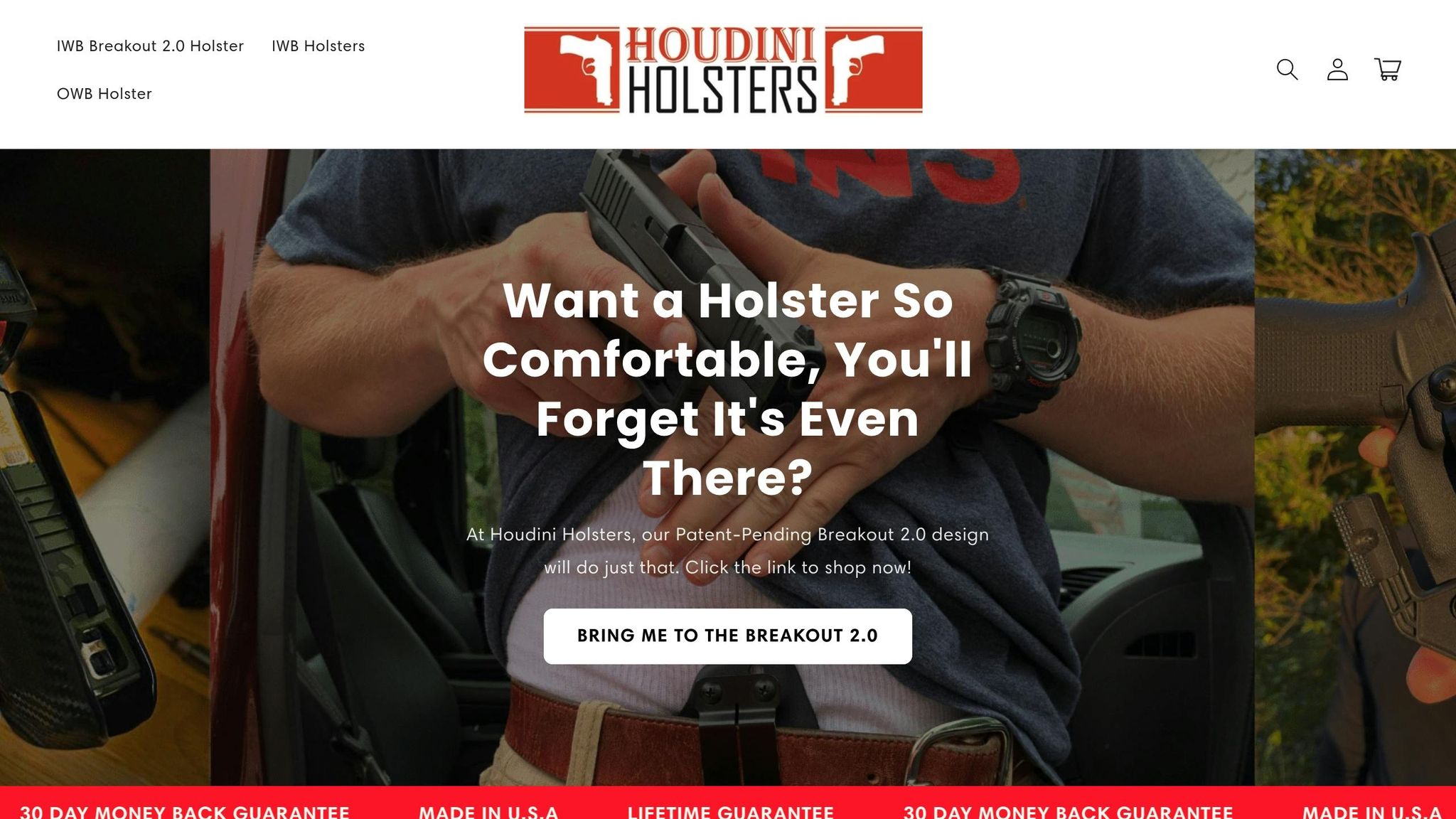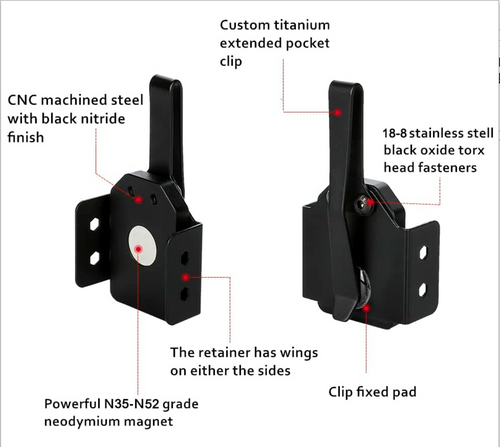Choosing the right Inside-the-Waistband (IWB) holster is crucial for safe and comfortable concealed carry. Here’s what you need to know upfront:
- Comfort is key: An uncomfortable holster means you’re less likely to carry consistently. Look for adjustable ride height, cant angle, and materials that prevent chafing or pressure points.
- Safety matters: Ensure the holster fully covers the trigger guard and securely retains your firearm.
- Concealment features: Opt for slim designs, tuckable clips, and wedges to reduce printing and keep your firearm hidden.
- Material options: Kydex offers durability and moisture resistance, while leather molds to your body but requires upkeep.
- Carry positions: Choose based on accessibility and comfort - appendix (1 o’clock) for quick access, or behind-the-hip (4–5 o’clock) for better concealment.
Quick Comparison of Holster Materials
| Material | Pros | Cons |
|---|---|---|
| Kydex | Durable, moisture-resistant | Rigid, may need break-in |
| Leather | Comfortable, molds to body | Needs care, sensitive to moisture |
| Nylon | Lightweight, budget-friendly | Less durable, weaker retention |
IWB Holster Basics
What IWB Holsters Do
Inside-the-Waistband (IWB) holsters hold your firearm securely inside your pants using one or two spring metal clips and a 1.5-inch trouser belt. They keep the gun steady and hidden, with only the grip visible above the beltline. These holsters are a popular choice for concealed carry due to their practicality.
Advantages of IWB Carry
IWB holsters provide excellent concealment by positioning the firearm inside your waistband, minimizing the chances of printing. Their design spreads the weight of the firearm, making them more comfortable for long periods of wear. Many models also allow you to tuck in your shirt over the holster for added discretion.
IWB Carry Positions
The position where you carry your holster plays a big role in comfort and accessibility. The clock-face system is often used to describe IWB positions, with 12 o'clock marking the front of your body:
| Position | Location | Best For |
|---|---|---|
| Appendix (AIWB) | 1 o'clock | Quick access, seated draw |
| Strong Side | 3 o'clock | Natural draw angle |
| Behind Hip | 4–4:30 | Traditional carry |
| Kidney | 5 o'clock | Deep concealment |
Each position has its pros and cons. For example, appendix carry provides fast access but can be less comfortable when sitting, while behind-the-hip carry offers better concealment. Tweaking the holster's cant and ride height can further improve how well it hides and how easy it is to draw. IWB holsters are most effective when paired with small to medium-sized handguns.
How to Select an IWB Holster
Comfort and Fit
Comfort is key to consistently carrying your firearm. A good IWB holster should allow adjustments for ride height and cant angle so you can customize its fit to your body and carry style. When assessing comfort, consider the following:
| Comfort Factor | Impact | Solution |
|---|---|---|
| Pressure Points | Can cause localized discomfort | Ensure the handgun sits flush against your body |
| Friction | May lead to skin irritation | Use a moisture-wicking undershirt |
| Weight Balance | Causes uneven belt pull | Position the gun closer to your centerline |
| Skin Contact | Can result in chafing | Opt for holsters made with moisture-resistant materials |
Once comfort is addressed, focus on ensuring the holster securely retains your firearm.
Safety and Retention
A safe holster keeps your firearm firmly in place while still allowing for quick access. IWB holsters typically rely on a mix of holster design, body pressure, and belt pressure to achieve proper retention. For concealed carry, a Level 1 friction-fit retention system is usually sufficient.
To test retention, wear the holster with an unloaded firearm and perform active movements like jumping jacks or running. Avoid relying on the 'shake test,' as it doesn’t mimic real-world scenarios.
After confirming safety, focus on concealment techniques.
Concealment Methods
Good concealment starts with proper holster positioning. The holster should hold your firearm close to your body to reduce printing through clothing. Features that help with concealment include:
- Adjustable ride height to position the grip for better concealment
- Tuckable clips for use with dress shirts or formal attire
- Wedge or wing designs to press the grip inward
- Slim profiles that reduce bulk around the trigger guard
Materials and Build Quality
The material of your holster greatly affects its comfort, durability, and overall performance. Here’s a breakdown of common materials:
| Material | Pros | Cons |
|---|---|---|
| Kydex | Moisture-resistant, precise fit, low maintenance | Can feel rigid; may need a break-in period |
| Leather | Comfortable, molds to your body | Requires regular care; sensitive to moisture |
| Nylon | Lightweight, budget-friendly | Less durable and offers weaker retention |
Kydex is a popular choice for its durability and moisture resistance. Leather is also a comfortable option as it molds to your body, but it needs consistent upkeep and can be affected by moisture over time.
Matching Holsters to Your Firearm
Model-Specific Fit
Getting the right fit for your holster is key for both safety and performance. A well-fitted holster secures your firearm and ensures a smooth, reliable draw. Keep these factors in mind when checking the fit:
| Fit Component | Importance | What to Look For |
|---|---|---|
| Trigger Guard | Prevents accidental discharge | Fully covers the trigger with no gaps |
| Sight Channel | Protects raised sights | Provides enough clearance for sights |
| Slide Length | Affects concealment and comfort | Matches your firearm’s barrel length |
| Frame Size | Ensures proper retention | Fits snugly around the grip and slide |
Once you’ve confirmed the fit, consider how any firearm attachments might affect your holster choice.
Working with Attachments
If your firearm has attachments, you’ll need a holster designed to handle those extra features. Here’s what to look for:
-
Light-Bearing Holsters
These are designed with extra space to fit weapon lights while maintaining secure retention. -
Optic Cut Options
For firearms equipped with red dot sights or similar optics, choose holsters with specific cutouts. These cutouts help protect the optic and allow for quick target acquisition. -
Suppressor-Height Sights
If your firearm has raised sights, make sure the holster includes a sight channel tall enough to prevent snagging or damage during the draw.
Position and Angle Setup
Once you’ve secured the right fit and accounted for attachments, adjust the holster’s angle to enhance comfort and accessibility.
"Holster cant is the angle at which the gun ride in the holster. A gun that is carried vertically in the holster has zero degree of cant and is in a neutral or 'straight-drop' position." – Urban Carry Holsters
To find the best position, start with an unloaded firearm while seated. Make small adjustments to balance concealment with ease of access.
| Carry Position | Suggested Cant | Advantages |
|---|---|---|
| 3–4 o'clock | 0–15° forward | Natural draw angle with less printing |
| 4–5 o'clock | 15–30° forward | Better concealment and seated comfort |
| Appendix | 0–10° | Fast access with minimal movement |
sbb-itb-7fb5bb8
Beginner's Guide To IWB Holsters For Concealed Carry ...
Best IWB Holsters for New Users
If you're just starting out with concealed carry, it's important to choose a holster that prioritizes fit, safety, and ease of use. Here’s a guide to help you find the right one.
Houdini Holsters Breakout 2.0

The Breakout 2.0 is designed to make concealed carry comfortable and straightforward, especially for beginners. Its patent-pending design solves many common issues that new users face, offering features that improve safety and usability:
| Feature | Benefit | Details |
|---|---|---|
| Full Trigger Guard | Added Safety | Fully covers the trigger to prevent accidental discharge |
| Adjustable Retention | Custom Fit | Lets you fine-tune how securely your firearm is held |
| Body Shield Extension | Better Comfort | Stops the firearm from rubbing against your skin |
| Multi-Position Clips | Flexible Carry | Adjusts for ride height and angle preferences |
This holster is priced at $69.99 and comes with a lifetime warranty, plus a 30-day money-back guarantee. It’s a solid option for anyone looking to balance comfort, retention, and concealment.
Key Features for Beginners
When choosing a holster, focus on these important features:
| Feature | Why It’s Important | What to Look For |
|---|---|---|
| Retention Level | Keeps Firearm Secure | Should hold the gun firmly, even if the holster is turned upside down |
| Draw Access | Quick and Easy | Allows for a smooth, fast draw |
| Concealment Design | Stays Hidden | Look for wings or claws that help tuck the grip closer to your body |
| Belt Compatibility | Provides Support | Works well with a sturdy gun belt for stability |
These features are critical for safe and effective concealed carry. Once you've chosen a holster, it’s time to break it in for optimal performance.
New Holster Break-in Guide
Breaking in your holster ensures it fits and functions perfectly. Here’s how to do it:
-
Initial Inspection
Tighten all screws and mounting points, but avoid changing the holster’s shape. -
Retention Adjustment
Start with a looser retention setting. Gradually tighten it until your firearm feels secure but is still easy to draw. -
Position Testing
Try different carry positions with your everyday clothing to find what works best for you:- 3–4 o'clock for hip carry
- 12–1 o'clock for appendix carry
- 4–5 o'clock for behind-the-hip carry
Taking the time to adjust and test your holster will ensure it performs well and feels comfortable throughout the day.
Conclusion
This guide has covered the key factors to consider when choosing an IWB holster that balances safety and effective concealed carry. Statistics back up the importance of these decisions: 96% of users reported better comfort, while 93% felt more confident in their concealment.
When picking your first IWB holster, prioritize these features:
- Full trigger coverage
- Adjustable retention
- Flexible positioning options
- Compatibility with your gear
Feedback from experienced users highlights the value of these features. NRA Pistol Instructor Brian J. shared:
"The B2.0 is amazing, and I've been religiously using it and spreading the word"
For $69.99, the Breakout 2.0 holster offers a solution for comfort and confidence. As user Richard S. put it:
"I just about gave up on concealed carry, but this holster truly WORKS. I carry all day & nearly forget it's there"
To get the most out of your holster, spend time breaking it in and adjusting it to your needs. Fine-tune the retention, experiment with different carry positions, and ensure it works with your daily wardrobe. With the right setup, concealed carry can be both comfortable and practical for everyday use.




